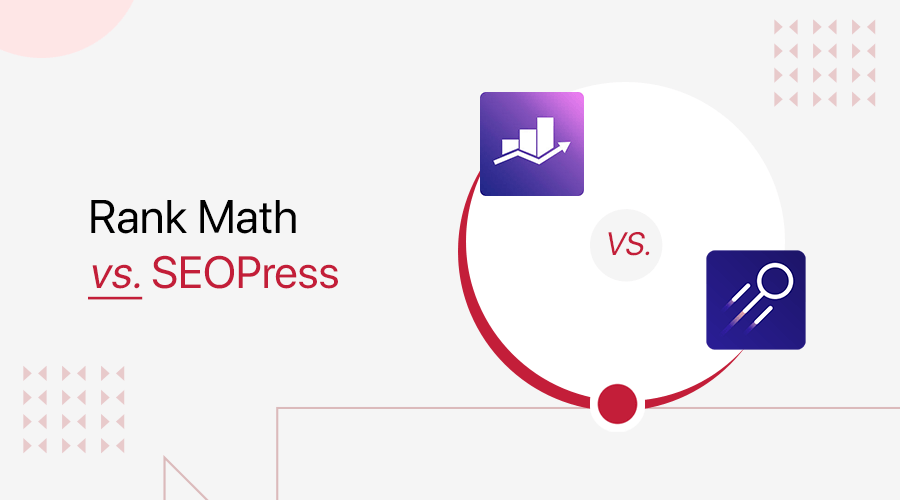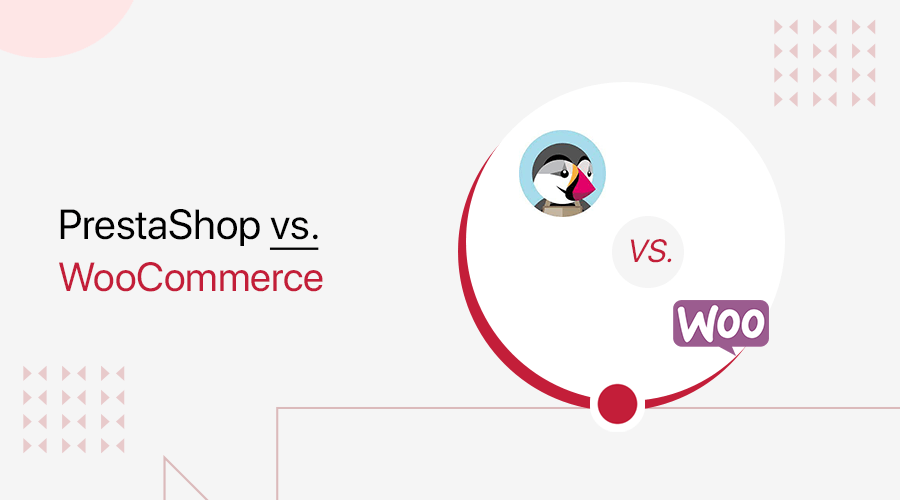
Are you having doubts about PrestaShop vs WooCommerce? Or looking for the best eCommerce builder for launching your online business? And cannot decide which one is a better eCommerce platform for your store.
Setting up your store on your own is not only exciting but can also be nerve-wracking sometimes. You have to make sure of many elements before even starting building your eCommerce store.
Among them, choosing the right eCommerce platform for your store can be quite overwhelming. Hence, we think that PrestaShop and WooCommerce are two eCommerce platforms that can help you easily launch almost any type of online store.
So, to help you out, we present to you the comparison between “PrestaShop vs WooCommerce”. We’ll compare them side by side in their features, pricing, ease of use, support, security, and more. We hope to break down what each platform has to offer depending on your needs.
Let’s get started!
A. PrestaShop vs WooCommerce – Introduction
First of all, let’s begin our comparison with a brief overview of PrestaShop vs WooCommerce.
What is PrestaShop? – Overview
PrestaShop is a free self-hosted eCommerce platform that provides a variety of features to build and run an online store. It was first launched back in 2007 with its headquarters in France.

Besides, it’s an open-source that allows its users to immediately launch and host their online store directly from the platform. Likewise, being a self-hosted platform, users themselves have to arrange their own domain and hosting and that’s the same for WooCommerce too.
Furthermore, PrestaShop comes with its own marketplace for templates and add-ons called PrestaShop Templates and PrestaShop Add-ons Marketplace. And most of the themes and add-ons found come in both free and premium versions.
Moreover, you can find third-party theme marketplaces that offer a wide range of themes to make your store look more unique.
What is WooCommerce? – Overview
WooCommerce is a fully customizable and open-source WordPress plugin designed for eCommerce. It helps you turn any WordPress site into an eCommerce site with eCommerce elements.

Besides, it allows you to sell an unlimited amount of products on your WooCommerce-powered site. Here, you’ll be able to sell products from physical to digital products, including subscriptions and downloadable content.
Since it’s an open-source platform, you’ll get more than hundreds of contributors worldwide making WooCommerce a versatile platform. Plus, it’s 100% customizable and comes with more than 400 extensions. Also, it integrates seamlessly with other WordPress plugins.
Just like in PrestaShop, WooCommerce also comes with its own marketplace for extensions called WooCommerce Marketplace. You’ll find here an extension (plugin) for everything and many of them are also free to use while others cost money.
Lastly, just like for extensions, WooCommerce is also popular with third-party theme developers. If you don’t find a theme you like in its Theme Store, then there are lots of other places to find them.
B. PrestaShop vs WooCommerce – Major Key Features
Any good eCommerce platform must include all the features you need to build a better online store. Hence, let’s find out what major features PrestaShop and WooCommerce have to offer.
PrestaShop’s Main Features
- It’s a free open-source solution that guarantees a secure, scalable, flexible, and sustainable solution for all your eCommerce projects.
- Offers free and premium PrestaShop Templates to create professional designs and customize your store in just a few clicks.
- PrestaShop comes with a stock management system that keeps track of each product in the inventory.
- Allows you to create special offers for your customers – configure coupons, offer free shipping, create price rules, etc.
- To increase engagement, it reduces the abandonment cart rate by sending emails. Plus, it helps in re-engaging customers by sending them an email containing viewed products.
- Comes with a PrestaShop Module Store that has 3,000+ PrestaShop modules to add relevant eCommerce features to your store.
- You can highlight your product via suggesting products to your customers, using a slider to promote products, and adding gift wrapping.
- With PrestaShop, you can run geographical delivery zones and apply shipping carriers for your store.
- Provides a full range of insights about your store and tracks your progress. Plus, give an overview of your most popular products and highlight them in your store.
- Let’s create templates of emails and send the default emails to your customers to inform them about the evolution of their orders.
- Allows you to run multiple stores in the same back office.
- Comes in 75+ different languages that help your eCommerce business succeed irrespective of your customers’ country or currency.
WooCommerce’s Main Features
- You can find countless themes and templates in its WooCommerce Theme Store to make your online store look exactly the way you want.
- It comes with WooCommerce Blocks that help you to select and display products in a modular way.
- 100% customizable and lets you easily customize the design and layout of your online store with a visual builder or through the code.
- You can display and sell any physical and digital goods, product variations, subscription options, instant downloads, single items, or bundles.
- WooCommerce Marketplace – There you can find hundreds of free and paid WooCommerce extensions for every possible function an online store could need.
- Seamlessly integrates with thousands of other WordPress plugins to enhance the functionality of your store.
- Offers flexible and secure payments with 140 region-specific gateways to choose from and integrate with. That includes WooCommerce Payments, Stripe, PayPal, Square, and Amazon Pay.
- You can create your own free WooCommerce mobile app so that you can manage your store from anywhere.
- With WooCommerce, you can configure your shipping options right from your dashboard. Also, schedule a pickup with WooCommerce Shipping (the U.S. only).
- For better search engine ranking, it comes with advanced product sorting and filtering systems.
- Offers multilingual content and prices in multiple currencies with 100% translated into 24 languages, including Danish, Ukrainian, and Persian.
- To boost your sales, it allows you to list your products on Google Shopping, promote your store on Facebook or email customers with Mailchimp.
Winner – Tie
After looking into the key features of PrestaShop and WooCommerce we’ve concluded that it’s a draw between them both. They both offer almost unlimited opportunities with their themes and plugins to extend the functionality of your store.
However, PrestaShop seems to offer a few more features, mostly focusing on products and selling. Whereas, with WooCommerce, you’ve got a much more extended set of tools backed by WordPress itself.
C. PrestaShop vs WooCommerce – Easy to Use and Interface
Now in this section of comparison, we’ll compare PrestaShop and WooCommerce for their ease of use. Plus, we’ll also look at how simple and user-friendly their interface is.
PrestaShop
The best thing about PrestaShop is that you can download and install the software for free on your server. And since PrestaShop is one of the popular eCommerce platforms, several web providers will handle the initial setup for you.
However, if not then setting up the PrestaShop can be a bit technical and in some cases, then you might need to take help from the experts. Now, once you’ve installed PrestaShop, you’ll have access to your PrestaShop dashboard that looks like this:

As you look closer at its dashboard, you’ll find that the layout of the dashboard is quite similar to that of WordPress. Since all the principal menus are systematically placed on the left side of the dashboard. And from there you can add goods, edit product information, design your shop, and include add-ons.
Similarly, the right side of the dashboard displays and acts as a workstation for their corresponding options. Hence, the interface looks quite user-friendly and has no hidden tricks to discover and operate your PrestaShop store properly.
Adding Products to PrestaShop Store
Now to start adding the products to the store, go to the PrestaShop dashboard and from there navigate to Catalog > Products > New Product.
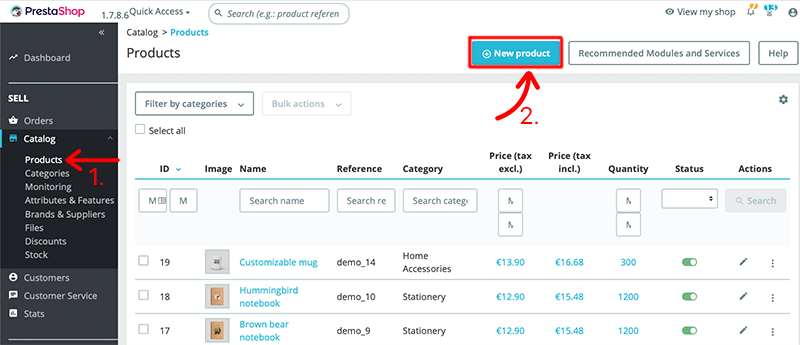
After that, it opens a visual editor to create and add a product to your eCommerce store. Inside that editor, you’ll get everything you need to create a product.
For instance, you’ll begin creating a product by entering the product name, description of the product, uploading their respective images, and more.

Once you’ve added the basic details to your products, you can further configure the settings of each product as you wish. At the top of the page, you’ll find more menu options that you can configure while adding your products.

For instance, in the SEO option, you can improve the ranking and appearance of your product page in search results. All you need to do is add meta titles, descriptions, and friendly URLs.
Now that we’ve looked into a part of how we can add products to our PrestaShop store, isn’t it simple?
WooCommerce
Unlike PrestaShop, WooCommerce is a free WordPress plugin that you can install from the WordPress plugin directory. But before installing WooCommerce, make sure to purchase a domain name, hosting service, and SSL certificate first. After that, you’re good to go.
Once the plugin is installed completely, in your WordPress dashboard, you’ll find the WooCommerce menu option on the sidebar. Alongside that, there are three more options added to it – Products, Analytics, and Marketing.
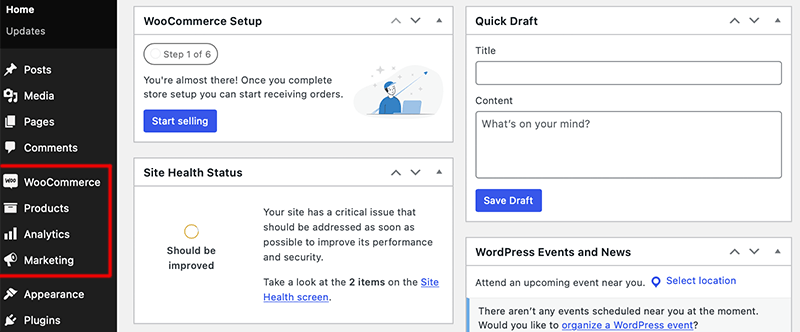
For more setting options hover over the WooCommerce option and find all the features are consolidated into one area. Within that options, you’ll find setting tabs for orders, coupons, reports, extensions, status, and more.

Now that you’ve found options to configure the WooCommerce settings for your online store as per your need. It’s time to find out how we can configure the look and customization of our store.
The customization of your store usually depends upon the WooCommerce theme that you choose for your store. Likewise, you can customize your theme using WordPress’s default Visual Customizer to quickly upload logos, manage fonts, adjust colors, etc.

Adding Products to The WooCommerce Store
As for adding products to your WooCommerce store, you have to go to Products > Add New from your WordPress dashboard and then add your products.
After that, it takes you to the editor page that looks similar to the editor of a post or page on WordPress. Now you can begin by adding the product title, product description, and category.
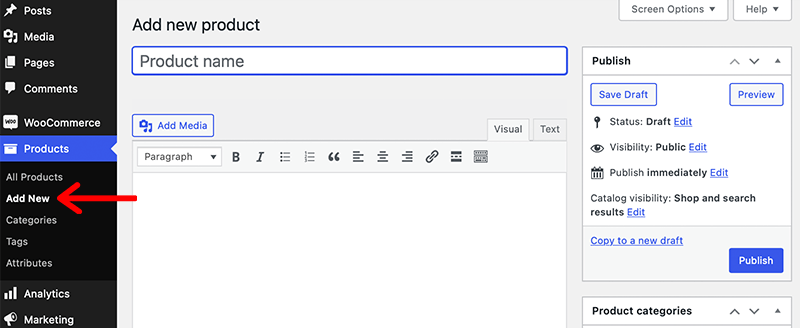
Similarly, as you scroll down the page, in the Product Data section, you need to select the type of product that you’re selling. For instance, you need to choose from the option of whether the product is a virtual or downloadable or even a simple, grouped, or variable product.
Likewise, in its General tab, you can set the regular as well as the sale price for the product. After that, you’ll find more setting options for features like shipping, inventory, attributes, and linked products.
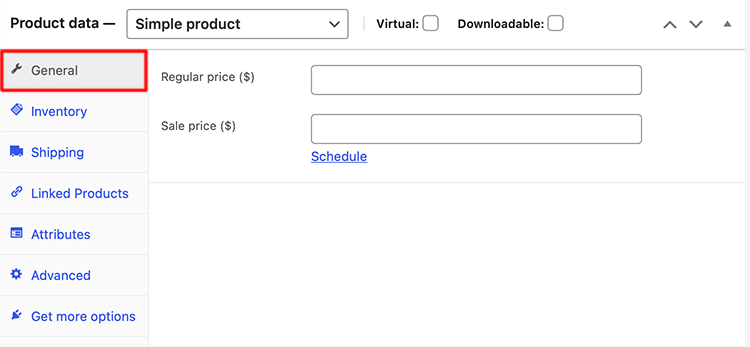
Lastly, to make your product more appealing and eye-catching add some images and videos to the product.
Winner – Tie
Both PrestaShop and WooCommerce have simple yet intuitive dashboard interfaces. Not just that they’re even quite user-friendly too. You’ll have all the features and tools placed within a reaching distance from your dashboard.
Yet somehow, PrestaShop can be quite technical when it comes to setting up the store at the very beginning. And WooCommerce comes with a slight learning curve especially if you’re not a WordPress user. So, we give this round a tie.
D. PrestaShop vs WooCommerce – Designs and Templates
Thus, we’ll look at the design and template options in PrestaShop and WooCommerce. Since those are the main reasons that’ll help you to design a beautiful website layout and grab visitors’ attention.
PrestaShop
As we talk about the design and templates, PrestaShop allows you to build your online store from scratch using one of their free templates. These free templates are good at the beginning if you’ve just started with your new online business.
However, as you grow, you require more dynamic elements for your growing business. Hence, in no time, you’ll have to purchase one of its niche-based templates for your store.
To your surprise, PrestaShop comes with its own template marketplace called PrestaShop Templates. In this, you’ll find over 2000+ template layouts that are 100% customizable and help you boost your conversions with a recognizable design.

And if we talk about the cost of templates, then it ranges from free to $300. The templates that you get here can edit the underlying code by accessing HTML, CSS, and JS files. Therefore, some programming and technical skills will definitely come in handy.
Besides, if you don’t have any technical skills then for such users, then there is a WYSIWYG editor. With this editor, you’ll be able to make changes to your default theme according to your needs. Also, it’ll allow you to add your own logo, change the page layouts, and update your page’s content.
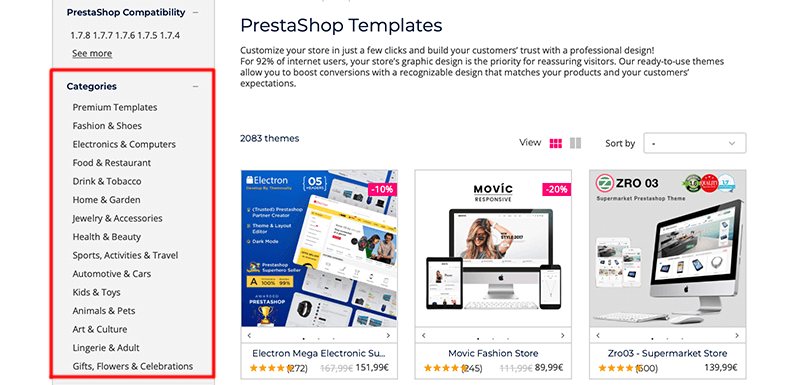
Similarly, if we come back to the PrestaShop Templates marketplace, then you’ll find 15 different categories of themes. Such as fashion & shoes, kids & toys, art & culture, health & beauty, etc.
Plus, you can use the filter options to search your required templates based on languages, extra functionalities, and developer types.
WooCommerce
With WooCommerce, you’ll get 49 themes that you can choose from and among them 3 of them are free. In the WooCommerce Theme Store, you’ll find themes are categorized into a huge number of industries, from arts and crafts to pet care.
Alongside that, themes can be further categorized into three more categories too – Free (3), Storefront Themes (14), and Responsive (37).

Besides, Storefront is the official theme for WooCommerce. This is also the reason why everyone recommends WooCommerce for beginners. Since it’s a free theme that seamlessly integrates with WooCommerce extensions and updates.
However, if you want to extend the functionality of that theme, then you can go with the Storefront child themes that have a range from $0 to $39.

All the different themes that you get in the theme store will allow you to customize things like menus, navigation, widgets, and social media integration. Similarly, every time you upgrade your WooCommerce site, the colors, styles, fonts, and stock images will also change depending on the themes.
Along with all this, you can also find a wide range of other stunning WooCommerce themes made by 3rd parties. For instance, you can find thousands of free themes inside the WordPress theme directory or go to a marketplace such as Themeforest for premium themes.
However, when you switch from one to another theme, there are some chances that you can lose the content of your site. But you can prevent this by strictly following WooCommerce’s Guide before switching between the themes.
Winner – WooCommerce
When it comes to themes and templates, WooCommerce seems to beat PrestaShop. Although PrestaShop has more template designs within its marketplace, WooCommerce still beats in the number with third-party themes.
Not only that, most of the themes that you get with PrestaShop are either overpriced or lack advanced features. On the other hand, WooCommerce has an official theme called Storefront which is the recommended theme for it.
To know more about the Storefront theme, check out our complete honest review on the WooCommerce Storefront theme.
E. PrestaShop vs WooCommerce – Extensions and Add-ons
In this section of PrestaShop vs WooCommerce, we’re going to look at what different extensions and add-ons each have to offer. These are an essential part of any site as it helps to add extra functionalities to the store.
Now, let’s begin with what PrestaShop has to offer in add-ons for your eCommerce site.
PrestaShop
Besides a wide range of PrestaShop templates, it also comes with PrestaShop Add-ons Marketplace. It has around 3800 modules that help the shop owners to customize and add functionalities to their online store for more traffic and improve conversion rates.
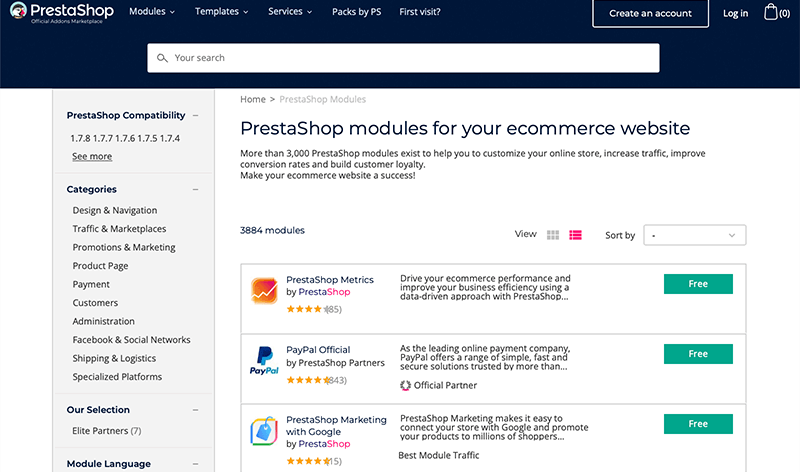
Some modules that you get here are completely free to use while most of them are available through a one-time purchase. In fact, adding premium modules can get quite expensive to boost your online store. The pricing of those premium modules ranges from $50 to $850 depending on your need.
Besides the pricing factor, using some of these modules may not be quite fruitful to build your website block-by-block. Because most of the modules you see here on the marketplace are made by different developers from all over the world.
Hence, it doesn’t guarantee that everything will work exactly as expected. Also, in that scenario, PrestaShop will not be able to help you with this since they didn’t create the add-ons. In the first place.
However, some of the notable PrestaShop modules that you can find in the marketplace are PayPal Official Module, Creative Elements, MigrationPro, Google Analytics, SEO Expert Module, and PrestaShop Metrics.
WooCommerce
Talking about WooCommerce and its integrations, WooCommerce is in the best place possible. Since WooCommere integrates with both third-party WordPress plugins and the WooCommerce extensions.
As we look into the Extensions Store of WooCommerce, you’ll find hundreds of free and paid extensions for payments, marketing, shipping, conversion, etc. In its store, you’ll find many extensions that are developed by third-party as well as developed by WooCommerce themselves.

However, we recommend you all go with the extensions that are usually developed by WooCommerce for your online store. They’re not only dependable but also sustainable and flexible. But some of them come with expensive costs too.
For instance, let’s look at some of the popular extensions of WooCommerce – WooCommerce Shipping, AutomateWoo, Google Analytics, Table Rate Shipping, Shipping Tracking, etc.
Similarly, if we look into WooCommerce integration with plugins, then there are lots of WordPress plugins that are designed for WooCommerce.

For instance, to convert and monetize the website traffic of your WooCommerce store you can use OptinMonster. Likewise, to improve the SEO score and strategy of your store you can use WordPress SEO plugins such as Yoast and AIO SEO.
Hence, you can find plenty of plugins for different purposes such as anti-spam, social media, marketing, and accounting. All you need to do is take quick research to find what functionalities you want for your online store.
Winner – WooCommerce
Both PrestaShop and WooCommerce have an extensive set of extensions and add-ons but WooCommerce is a step ahead here due to a few reasons.
For instance, WooCommerce has more free extensions and plugins that are built on top of WordPress. But within a PrestaShop, many add-ons and modules aren’t compatible with each other. Plus, PrestaShop modules are on the costlier side too.
F. PrestaShop vs WooCommerce – Pricing
Next, we have pricing which is another important consideration when you’re building an eCommerce store. Hence, it’s time to look at the pricing offered by PrestaShop and WooCommerce to find out which is better for starting your online store.
PrestaShop
To your surprise, PrestaShop is free to download and use since it’s an open-source platform. As a result, you can try it on your own with their demo site and have a look at the dashboard and store.
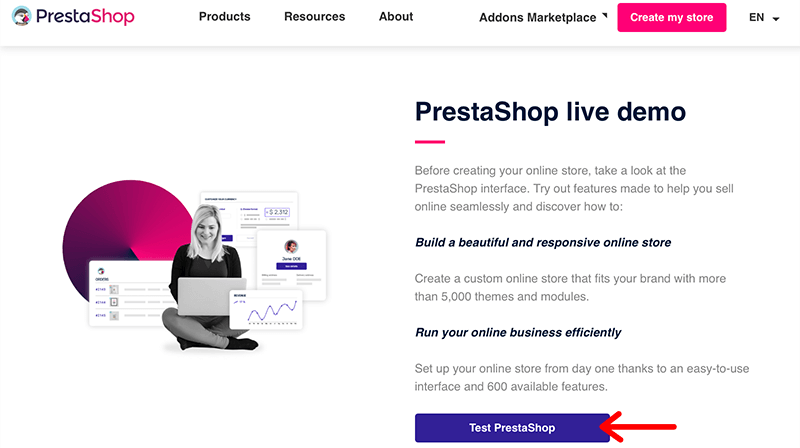
However, the only factors that you have to consider while building a store with PrestaShop would be domain and hosting. You need to make sure that you choose excellent eCommerce hosting services that offer you significant resources such as domain name, SSL certificate, unlimited bandwidth, and more.
Besides that, you’ll even have to spend quite a lot of money on some premium templates and add-ons. For instance, you’ll have to purchase their premium templates for more functionality ranging from $87 to $300.
Similarly, PrestaShop also comes with free add-ons and modules but its premium ones are generally expensive ranging from $50 to $850.
WooCommerce
WooCommerce is a free WordPress plugin. You can easily download and install it on your site from the WordPress.org official plugin repository.
Just like in PrestaShop, you’ll have to buy your hosting and domain name at the beginning of building an online store. However, we recommend you go with managed WooCommerce hosting services.
The hosting itself will take care of all the required resources for building your eCommerce site along with a free domain name and SSL certificate. So, you can keep your focus on building and growing your online store.
Alongside that, WooCommerce comes with both free and premium extensions. And they usually cost between $25 and $300 per year.
Similarly, for a better look and design, you need to purchase its premium WooCommerce themes which can cost between $20 and $250.
Winner – Tie
We again think it’s a draw between both platforms. As both of them are free open-source platforms that require a domain and hosting to launch an online store. Although, when it comes to themes and extensions, WooCommerce is still quite budget-friendly in comparison to PrestaShop.
But still, both have a selection of free themes and add-ons to offer a wide range of features with cost-effectiveness.
G. PrestaShop vs WooCommerce – Security
When it comes to security, every eCommerce platform tries to provide you with advanced security features to keep your store secure. Isn’t that what we want?
Here in this section of comparison, we’ll look at what each eCommerce platform has to offer to keep your store secure. Starting with PrestaShop.
PrestaShop
As discussed earlier, PrestaShop is an open-source platform so it does have a high chance of getting hacked or tampered with its software.
However, the best part is that its core platform is PCI and GDPR compliant. This means that it protects the privacy of your website’s users without affecting how you do your business.
Even with this, you have to make sure that you come forward to keep your website and its data secure. To do so you’ll have to implement your SSL encryption. But this thing can be taken care of easily if you go with good web hosting.
As most web hosting not only takes care of hosting and domain name but also provides a free SSL certificate. Alongside that, for better and more secure payment transactions, you must rely on relevant payment gateways.
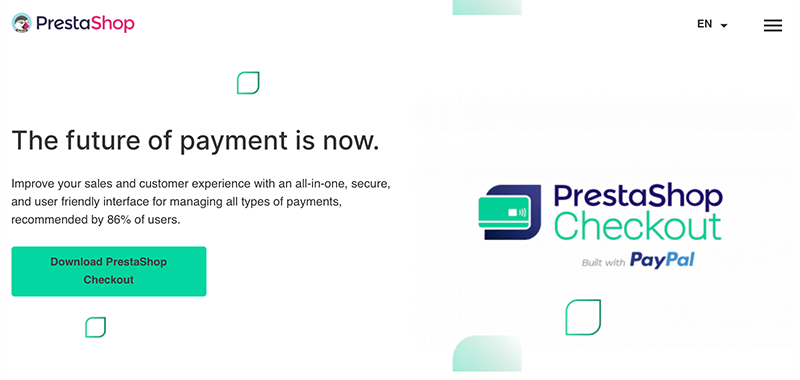
Hence, PrestaShop comes with over 250 payment gateways in the module store. Besides, it also offers an in-built PrestaShop Checkout payment gateway option that supports credit cards, PayPal, and other payment options.
WooCommerce
Just like PrestaShop, WooCommerce is also an open-source platform that requires you to keep it secure. That means the best way to keep your WooCommerce secure is to follow best security practices and use WordPress security plugins.
Not just that, at the very first, when you’re building your business, you must rely on good WooCommerce hosting. This will not only host your online store but also handle SSL and keep your file files secure.
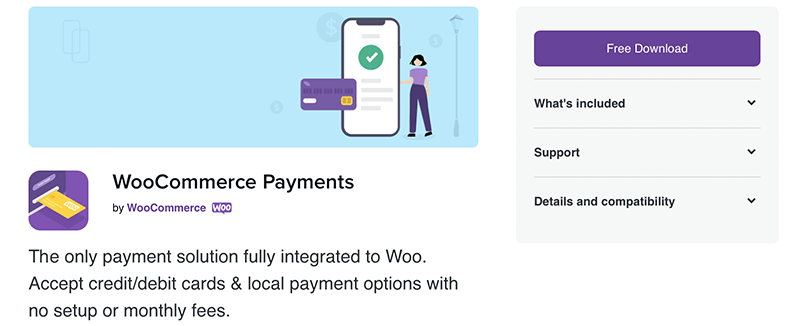
However, for safe and secure payments, WooCommerce itself comes with its payment solution called WooCommerce Payments. It’ll securely accept major credit and debit cards, and local payment methods on your site with no setup costs or monthly fees.
Likewise, you can also choose from 80+ payment gateways to allow your customers to pay you directly without leaving your WooCommerce store.
Winner – Tie
Both being open-source platforms, it’s upon you how you keep your store secure. And, when it comes to security, both of them provide good tools to secure your store and keep customers safe. As a result, both of them are neck to neck and get one point each to both.
H. PrestaShop vs WooCommerce – Customer Support
While building your eCommerce store, at some point you’ll need support from experienced experts to handle issues. Luckily, both PrestaShop and WooCommerce come with a handful of support options. Let’s look deeper into it.
PrestaShop
When it comes to providing customer support, PrestaShop mainly comes with two different types of support. The first one includes a huge library of free resources such as guides, tutorials, FAQs, and training courses.
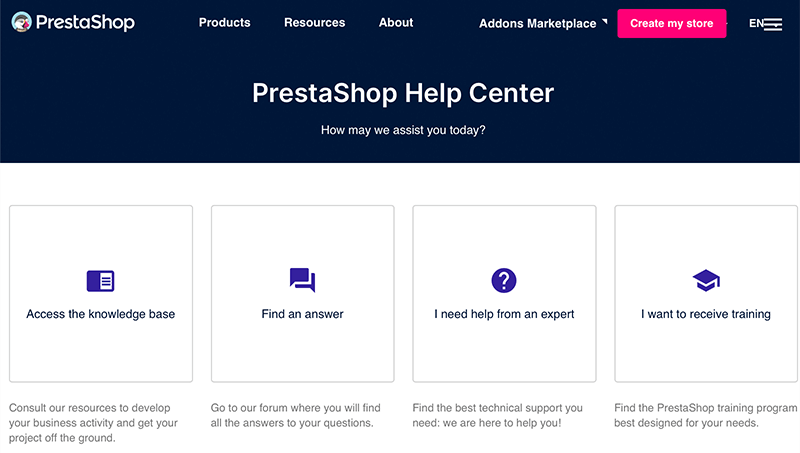
With that all, you’ll find most of its tutorials in video format. This makes it much easier to learn and understand the process of building an online store using PrestaShop.
Plus, it offers you a service called PrestaShop Translations. In this, you’ll get no less than 75+ language translations that help you broaden your business and fit the audience you target. Plus, you can also be their contributor and help them translate into your language.
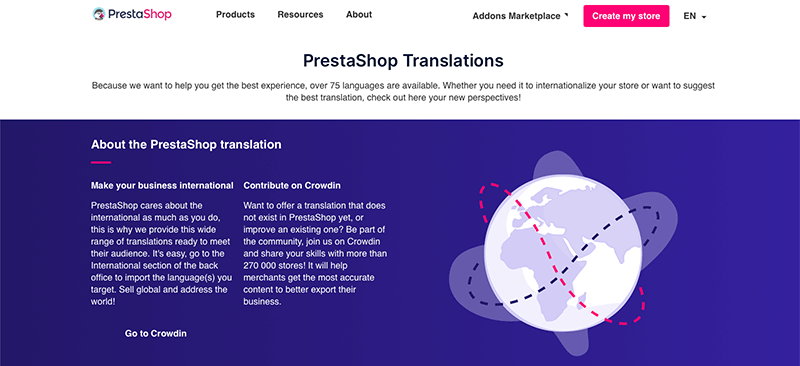
Similarly, the second form of support type would be the premium technical support option. If we look at their cost, then it’s outrageous and only offers limited service hours of help per year. Its cost ranges upward from $150 depending on what you need. Plus, you must sign up for at least one year of minimum subscription too.
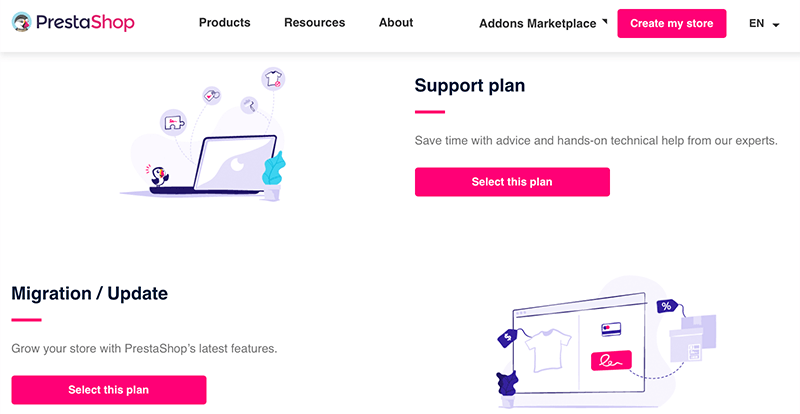
Lastly, if you don’t want to waste your time on this overpriced support, then you can use their live chat support. This option is available to you all when you visit the official PrestaShop website. Or else you can join its community forum and there you’ll find users who are ready to help you out.
WooCommerce
In comparison to PrestaShop, WooCommerce experiences fewer security vulnerabilities and they’re nearly error-free and bug-free. However, WooCommerce never disappoints you with its customer support although it provides limited options.
Although both the platforms are open-source, WooCommerce has a large community of developers and people working around it every day. Plus, you’ll find developers who’re maintaining and updating WooCommerce and releasing new versions all the time. Hence, you won’t find yourself looking for how to fix a bug in your store.

Besides all these, it also provides comprehensive support documentation that contains high-quality content and includes everything you’re likely to need. Indeed, it also offers FAQ sections and user forums with a helpful community who always seem willing to help.
When you’re following their community forum, you need to remember that the answers to your queries are not official all the time. Hence, you need to verify it before proceeding ahead.
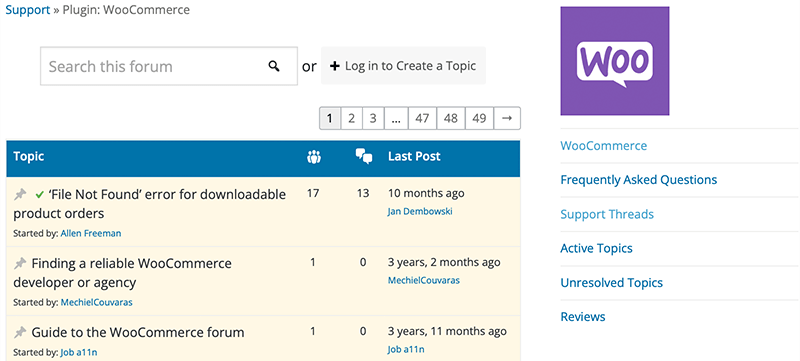
Unlike PrestaShop, WooCommerce doesn’t offer any sort of official premium support in case you need priority support. However, if you’re using any of their paid WooCommerce plugins and extensions, then you can get better customer support via emails, chat, etc.
Winner – WooCommerce
PrestaShop provides premium technical support plans. It’s still overly priced and most of the new or smaller stores may not be able to take advantage of it.
Similarly, WooCommerce seems to have a clear win with its huge library of well-documented tutorials, FAQs, and videos. Plus, it’s backed up by Automattic, so it is going to have a large community of users to help you through your journey.
I. PrestaShop vs WooCommerce – Comparison Table
| Features | PrestaShop | WooCommerce |
| Pricing | Free download and installation. | A free WordPress plugin to use. |
| Ease of Use | Beginner-friendly and easier to use. | Easy to get started with but has a slight learning curve. |
| Design and Templates | PrestaShop Templates has over 2000+ templates. | 49 themes are available within a WooCommerce Theme Store. |
| Apps and Integration | PrestaShop Module Store with 3,000 PrestaShop modules. | WooCommerce Marketplace with hundreds of free/paid WooCommerce extensions. |
| Mobile App | Yes | Yes |
| SEO Optimization | Limited SEO modules, most of them are paid. | Hundreds of WordPress SEO plugins are available. |
| Payment Gateways | PrestaShop Checkout with 250 payment gateways options. | WooCommerce Payments and 100+ payment gateways integration. |
| Multilingual Support | Comes with PrestaShop Translations | Need to integrate the WPML plugin. |
| Customer Support | Video Tutorials, FAQs, training courses, live chat support, community, forums, and premium technical support. | Knowledge base, FAQs, and community forums. |
| User Ratings | Trustpilot TrustScore – 4.1 out of 5. G2 Reviews – 4.3 out of 5. | Trustpilot TrustScore – 3.0 out of 5. G2 Reviews – 4.4 out of 5. |
J. PrestaShop vs WooCommerce – Pros and Cons
Now, in this section of PrestaShop vs WooCommerce, let’s find out the pros and cons of both services. Let’s start with PrestaShop.
Pros and Cons of PrestaShop
PrestaShop Pros
- Free open-source platform.
- Easy to set up and use.
- Has a modern storefront dashboard.
- Supports multiple payment gateways.
- 75+ language translation options.
- PCI compliant software.
PrestaShop Cons
- Limited and expensive customer support.
- Requires you to manually create your database.
- Expensive add-on marketplace.
- Has higher chances of security vulnerabilities.
Pros and Cons of WooCommerce
WooCommerce Pros
- Free open-source WordPress plugin.
- Offers plenty of customization options.
- Backed up by a very huge and active community of WordPress and WooCommerce users.
- Compatible with almost all of the WordPress plugins.
- Thousands of free and premium WooCommerce themes and extensions are available.
WooCommerce Cons
- Works only with WordPress-hosted websites.
- Sometimes the setup process can be quite a task for beginners and inexperienced users.
- Unlike PrestaShop, WooCommerce doesn’t offer a dedicated support option.
K. PrestaShop vs WooCommerce – Final Verdict
Both PrestaShop and WooCommerce stand out as excellent eCommerce builders for newbies. They both shine out the most when it comes to their powerful functionality, customization, ease of use, and support.
However, if you’re still stressing about which eCommerce builder to choose for building your online store, then let’s help you a bit more on this.
In short, if you’re familiar with WordPress and already have a WordPress site, then WooCommerce can be your go-to platform. Besides, most developers also lean towards WooCommerce since it integrates well with WordPress.
Not just that, its integration with WordPress gives it massive access to WordPress themes and plugins. Plus, it has a well-built community of WordPress and WooCommerce that are eager to help new users.
Whereas PrestaShop can be a better option for large-scale enterprises and WooCommerce for small to medium-sized eCommerce shops. With PrestaShop also, it’s quite easy to set up and manage your online store.
However, PrestaShop doesn’t have the leverage of WordPress. Hence, it has to depend upon a different suite of tools for marketing, content, sales, promotion, and social media integration.
Lastly, what we can say is that it’s all up to you. You must begin with good research before choosing your eCommerce platform for your store.
If you’ve decided to go with WooCommerce then, check out our complete guide on what WooCommerce is and how to use it.
Conclusion
That’s it! We’ve come to the end of this comparison article. After comparing PrestaShop vs WooCommerce, we hope you’ve made your choice.
Finally, we would like to say that these eCommerce builders are the best in their game.
If you have any further queries about PrestaShop vs WooCommerce, then please comment below. We’ll try to get back to you as soon as possible.
Also, let us know which one you are going to choose from. You can share your pick in the comments section below.
You may also like our other articles like the best multi-vendor eCommerce platforms for marketplaces and the best WooCommerce loyalty points & rewards plugins. Be sure to go through it once.
Also, don’t forget to follow us on Facebook and Twitter for more updates.

